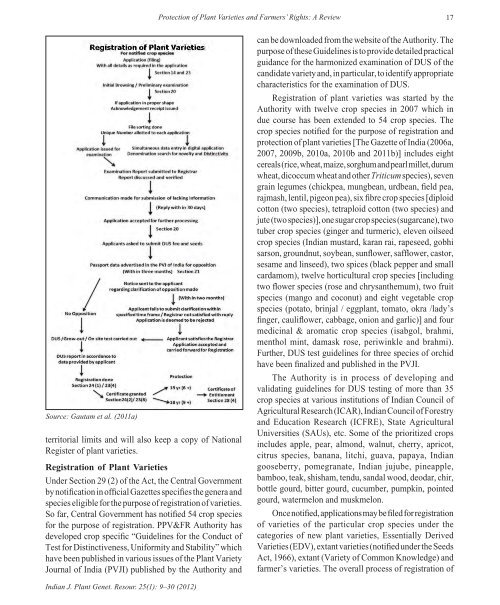indian society of plant genetic resources - Bioversity International
indian society of plant genetic resources - Bioversity International
indian society of plant genetic resources - Bioversity International
You also want an ePaper? Increase the reach of your titles
YUMPU automatically turns print PDFs into web optimized ePapers that Google loves.
Source: Gautam et al. (2011a)<br />
territorial limits and will also keep a copy <strong>of</strong> National<br />
Register <strong>of</strong> <strong>plant</strong> varieties.<br />
Registration <strong>of</strong> Plant Varieties<br />
Under Section 29 (2) <strong>of</strong> the Act, the Central Government<br />
by notifi cation in <strong>of</strong>fi cial Gazettes specifi es the genera and<br />
species eligible for the purpose <strong>of</strong> registration <strong>of</strong> varieties.<br />
So far, Central Government has notifi ed 54 crop species<br />
for the purpose <strong>of</strong> registration. PPV&FR Authority has<br />
developed crop specifi c “Guidelines for the Conduct <strong>of</strong><br />
Test for Distinctiveness, Uniformity and Stability” which<br />
have been published in various issues <strong>of</strong> the Plant Variety<br />
Journal <strong>of</strong> India (PVJI) published by the Authority and<br />
Indian J. Plant Genet. Resour. 25(1): 9–30 (2012)<br />
Protection <strong>of</strong> Plant Varieties and Farmers’ Rights: A Review 17<br />
can be downloaded from the website <strong>of</strong> the Authority. The<br />
purpose <strong>of</strong> these Guidelines is to provide detailed practical<br />
guidance for the harmonized examination <strong>of</strong> DUS <strong>of</strong> the<br />
candidate variety and, in particular, to identify appropriate<br />
characteristics for the examination <strong>of</strong> DUS.<br />
Registration <strong>of</strong> <strong>plant</strong> varieties was started by the<br />
Authority with twelve crop species in 2007 which in<br />
due course has been extended to 54 crop species. The<br />
crop species notifi ed for the purpose <strong>of</strong> registration and<br />
protection <strong>of</strong> <strong>plant</strong> varieties [The Gazette <strong>of</strong> India (2006a,<br />
2007, 2009b, 2010a, 2010b and 2011b)] includes eight<br />
cereals (rice, wheat, maize, sorghum and pearl millet, durum<br />
wheat, dicoccum wheat and other Triticum species), seven<br />
grain legumes (chickpea, mungbean, urdbean, fi eld pea,<br />
rajmash, lentil, pigeon pea), six fi bre crop species [diploid<br />
cotton (two species), tetraploid cotton (two species) and<br />
jute (two species)], one sugar crop species (sugarcane), two<br />
tuber crop species (ginger and turmeric), eleven oilseed<br />
crop species (Indian mustard, karan rai, rapeseed, gobhi<br />
sarson, groundnut, soybean, sunfl ower, saffl ower, castor,<br />
sesame and linseed), two spices (black pepper and small<br />
cardamom), twelve horticultural crop species [including<br />
two fl ower species (rose and chrysanthemum), two fruit<br />
species (mango and coconut) and eight vegetable crop<br />
species (potato, brinjal / egg<strong>plant</strong>, tomato, okra /lady’s<br />
fi nger, caulifl ower, cabbage, onion and garlic)] and four<br />
medicinal & aromatic crop species (isabgol, brahmi,<br />
menthol mint, damask rose, periwinkle and brahmi).<br />
Further, DUS test guidelines for three species <strong>of</strong> orchid<br />
have been fi nalized and published in the PVJI.<br />
The Authority is in process <strong>of</strong> developing and<br />
validating guidelines for DUS testing <strong>of</strong> more than 35<br />
crop species at various institutions <strong>of</strong> Indian Council <strong>of</strong><br />
Agricultural Research (ICAR), Indian Council <strong>of</strong> Forestry<br />
and Education Research (ICFRE), State Agricultural<br />
Universities (SAUs), etc. Some <strong>of</strong> the prioritized crops<br />
includes apple, pear, almond, walnut, cherry, apricot,<br />
citrus species, banana, litchi, guava, papaya, Indian<br />
gooseberry, pomegranate, Indian jujube, pineapple,<br />
bamboo, teak, shisham, tendu, sandal wood, deodar, chir,<br />
bottle gourd, bitter gourd, cucumber, pumpkin, pointed<br />
gourd, watermelon and muskmelon.<br />
Once notifi ed, applications may be fi led for registration<br />
<strong>of</strong> varieties <strong>of</strong> the particular crop species under the<br />
categories <strong>of</strong> new <strong>plant</strong> varieties, Essentially Derived<br />
Varieties (EDV), extant varieties (notifi ed under the Seeds<br />
Act, 1966), extant (Variety <strong>of</strong> Common Knowledge) and<br />
farmer’s varieties. The overall process <strong>of</strong> registration <strong>of</strong>

















